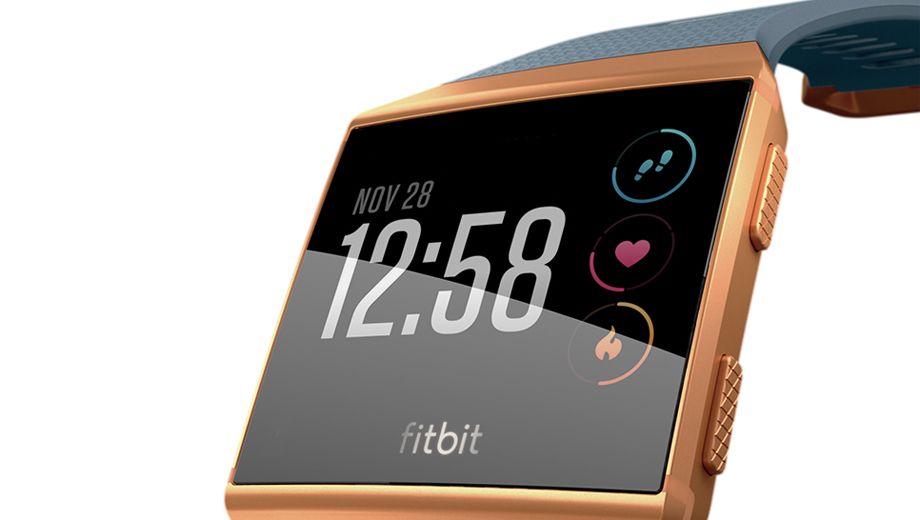Review: Fitbit Ionic is a smartwatch for the seriously sporty

Among the high-achieving, mostly urban-dwelling professionals who spend a lot of time, money, and psychic energy on endurance competitions, athletic ambitions are worn on the wrist.
That’s why investment bankers and executives helped make the Timex Ironman one of the best-selling watches in the world – a Rolex communicates wealth, but the Ironman says you’re serious about training in and out of the office.
I consider myself part of this demographic, not so much for my performance level as for my willingness to spend troubling amounts of money on workout clothes, event fees, and the airline tickets to get there.
And gear. Especially gear. I’ve had a Fitbit since the company introduced the Flex (an early model that looked like a bracelet) in 2007. I early-adopted the Charge (a bit bulkier, but with a larger screen), and finally the Blaze, Fitbit’s first real smartwatch, in January 2016.
So far, I’ve resisted the Apple Watch. The hype is a turnoff for me, but the bigger issue is its battery life - 18 hours, compared with almost five days for the Fitbit.
Now the San Francisco-based brand has released its most ambitious gadget to date: the Ionic, a sleek watch meant to replace the bulky GPS-enabled devices marathoners obsessively check during training runs and races.
I was especially intrigued by the notion of ditching the Garmin I’ve worn in tandem with my Fitbit for several years. The Fitbit was my daily watch, dutifully tracking my steps and calories and sleep, but it lacked Garmin’s GPS and heart-rate monitor.
As a practical matter, that meant I wore one on each wrist when I was running: a look that signaled I was trying a little too hard.
A more robust smartwatch would be a nice-to-have for me, but it’s a must-have for Fitbit, whose investors remain worried about competition from Apple and Samsung But they all take solace in a fast-growing market: According to IDC, sales of wearables may reach as much as US$34 billion by 2020, up from US$20 billion this year.
That cautious optimism also describes how I came away from the Ionic after spending a month running, swimming, and sleeping the smartwatch through its paces.
This version has potential: it’s far less reliant on the app than previous models, allowing more functionality directly on your wrist. I can set an alarm on the watch rather than choose my wake-up time on the app and wait for it to sync.
The look is more distinctive than that of its predecessor, which had a similarly square shape but required you to pop it out of the casing to charge it.

Notably, the Ionic caters to the fickle habits of today’s daily athlete, with a menu of exercise-tracking measurements that start with running, biking, and swimming. It’s also waterproof and counts laps automatically.
And there are options for treadmills and weights, helpful for keeping track of your timing and heart rate when you’re traveling and relegated to a hotel gym.
A much-improved holdover from previous versions is the Coach app, which leads you through a series of high-intensity workouts, including 7- and 14-minute ones designed to get your heart rate up and kick the rust out. It even shows clips that demonstrate various exercises, which is good, because I didn’t know what a “typewriter pushup” was.
That feature, says Fitbit’s director for product marketing, Michael Polin, is where the possibilities for this device become clear. An update will give the watch the ability to learn your strengths and adapt, steadily increasing the challenges in a workout.
At A$450, the Ionic is less expensive - but only slightly - than the Apple Watch Series 3, suggesting a coming arms race to develop the best apps.
It’s hard to bet against Apple when it comes to design and ease of use. The Ionic’s download times for music – played through wireless headphones – are still long. And Strava, the workout-tracking social network, comes preloaded, but an even richer interface that gives more data about runs and rides, along with those in Strava, would be welcome.
Polin says users should think of the watch as a platform that’s easy to build on. “The idea is that it’s better for you a year in than it was when you first got it,” he says. “I think of the hardware as being an enabler.” As if fitness addicts like me need another.

Hi Guest, join in the discussion on Review: Fitbit Ionic is a smartwatch for the seriously sporty